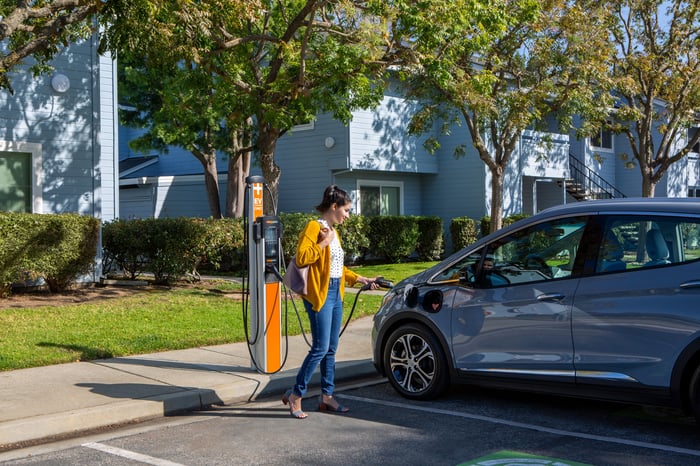The U.S. government surely believes that electric vehicles (EVs) are the future of transport. Electric vehicles can make transport far cleaner than it is today. To drive EV growth, the bipartisan infrastructure law provides for a $7.5 billion investment in EV charging infrastructure. The government aims to develop a network of 500,000 public chargers by 2030, representing a five-fold increase from the number of public chargers in the U.S. right now.
Despite strong expected growth in the number of electric vehicles and chargers, the stocks of electric vehicle charging providers fell in 2021. Leading EV charging company ChargePoint Holdings' (CHPT 0.74%) stock fell more than 50% in 2021. Let's discuss why that happened and whether the stock will recover in 2022.
The rise and the fall
Though a 50% fall sounds alarming, it doesn't look that alarming if you consider that ChargePoint stock rose nearly 300% in the second half of 2020. ChargePoint stock is still up roughly 50% from Sept. 24, 2020, when the company first announced its intention of going public via SPAC Switchback Energy Acquisition Corporation. By comparison, the stock has fallen more than 35% since ChargePoint went public in March this year.

The euphoria surrounding electric vehicle stocks at the start of 2021 came down during the year as investors digested the risks and valuations associated with EV stocks.
ChargePoint isn't profitable yet
Among the several challenges that electric vehicle charging companies face, attaining profitability is probably the top one. In the third quarter, ChargePoint reported a net loss of $69.4 million, which exceeded its revenue of $65 million. The company doesn't expect to generate positive EBITDA until 2024. ChargePoint is focused on top-line growth at the moment.
The company believes that as it builds a sizable customer base, it will be able to generate more high-margin recurring software revenue. While this plan makes sense, eventual profitability will likely depend on being a top EV charging provider with quality offerings and differentiation that will help customers stick to ChargePoint. There is a fair amount of uncertainty here.
There are several EV charging providers, both publicly listed and private, that can give tough competition to ChargePoint. The charging networks that some electric vehicle manufacturers have built or intend to build will also give stiff competition to the company.

Image source: ChargePoint.
ChargePoint is progressing well
ChargePoint boasts around 163,000 charging ports globally, with around 45,000 in Europe. In the third quarter, the company grew its revenue by 79% year over year. It also raised its revenue guidance for the full fiscal year (ending Jan. 31, 2022). At its mid-point, the company increased revenue guidance from $230 million to $237.5 million.
While ChargePoint earns upfront revenue from hardware sales, it generates substantial revenue from its software. Its Software-as-a-Service model should help it grow recurring revenue, as hardware sales increase. The EV charging provider reckons that, over time, the total recurring revenue from a typical EV charging unit, including software and service revenue, equates the hardware revenue from that unit. Overall, the company's growth plans look robust.
Is ChargePoint stock a buy?
Expected growth in electric vehicles and ChargePoint's leading position as an EV charging provider should support the company's growth in the coming years. On the flip side, intense competition and loss-making operations are its key challenges.
ChargePoint stock is right now trading close to its 52-week low, offering a more attractive entry point for investors looking to enter for the long term. But also note that the stock is still trading at a price-to-sales ratio of 27. If the company fails to grow as it is hoping, the stock could see a further correction from here. So, ChargePoint stock is suitable only for investors with a high level of risk tolerance.





